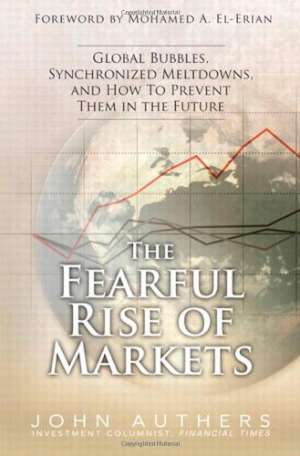14 June 2011
The Fearful Rise of Markets
John Authers
2010, FT Prentice Hall, 192 pages, £20
ISBN 9780137072996
Reviewer: Ian Harwood, Chief Economist, Evolution Securities

A wholly new genre of contemporary financial and economic analysis has emerged during the course of the past couple of years. This has focused exclusively upon the causes, and the likely consequences, of the worldwide credit crunch of 2008-09. As a result, booksellers’ shelves are now groaning under the burden of many tomes devoted to establishing what went wrong, who was to blame – and, crucially, how the world’s financial architecture can be re-designed in order to prevent such a disaster ever happening again.
Such a level of popular interest is hardly surprising. After all, only two years ago the global economy was sent into its worst tailspin – and asset markets into their most severe convulsions – since the early 1930s. In addition, these shocking reversals came in the wake of a period of prolonged robust and non-inflationary growth during which many, in time-honoured hubristic fashion, came to believe that the boom-and-bust economic cycle had been finally been abolished.
John Authers is an excellent and highly-experienced financial journalist, as readers of the FT will be fully aware. And his The Fearful Rise of Markets constitutes a valuable and stimulating contribution to the recent plethora of ‘credit crunch’ literature.
His book is divided into three parts. The first –by far the largest part of the book – is called ‘The Rise’ and tells the story of the rise of financial markets from the 1950s onwards, when they began slowly to emerge from under the shadow of the Great Depression. In so doing, Authers focuses upon what he considers to constitute the seminal events which led to the creation of the contemporary and extraordinarily huge and complex financial super-structure which has developed hand-in-hand with the process of economic globalisation. Thus, he concentrates upon the development of asset markets (primarily equities, bonds, credit and foreign exchange), their accompanying products (notably derivatives) and the meteoric growth and fateful intertwining of the respective fortunes of the fund management and banking industries. All this is highly educative to anybody interested in financial markets and offers a perspective not available elsewhere.
The second part – ‘The Fall’ – deals with what will be to most a much more familiar story: how the highly speculative and leveraged global financial situation began to unravel from early 2007 onwards. The final section – by far the shortest – focuses upon the ‘Fearful Rise’, the recovery we’ve seen in asset markets and financial stability from the dark days of only two years ago, when it really did seem that the world might be slipping into a desperately insecure, deflationary abyss.
Disappointingly – especially as I had so greatly enjoyed what went before – I found the concluding section surprisingly timid and unadventurous (but, after all, financial journalists, unlike stockbrokers, aren’t paid to offer predictions). It’s possible, moreover, to find fault with odd omissions. There is no mention, for instance, of the 1987 stock market crash, which saw, I would argue, the genesis of the ‘Greenspan put’, with the Fed’s stabilising pledge of unlimited liquidity. And certain arguments seem highly questionable: for example, the author’s contention that the sky-high oil price of mid-2008 was the result solely of “speculation”. Economists, moreover, may occasionally find themselves grinding their teeth in frustration at Authers’ neglect of key economic developments, whether the conquest of inflation or the ‘Great Moderation
Overall, however, the book is an excellent read and is highly recommended– particularly to those coming into financial markets for the first time.
